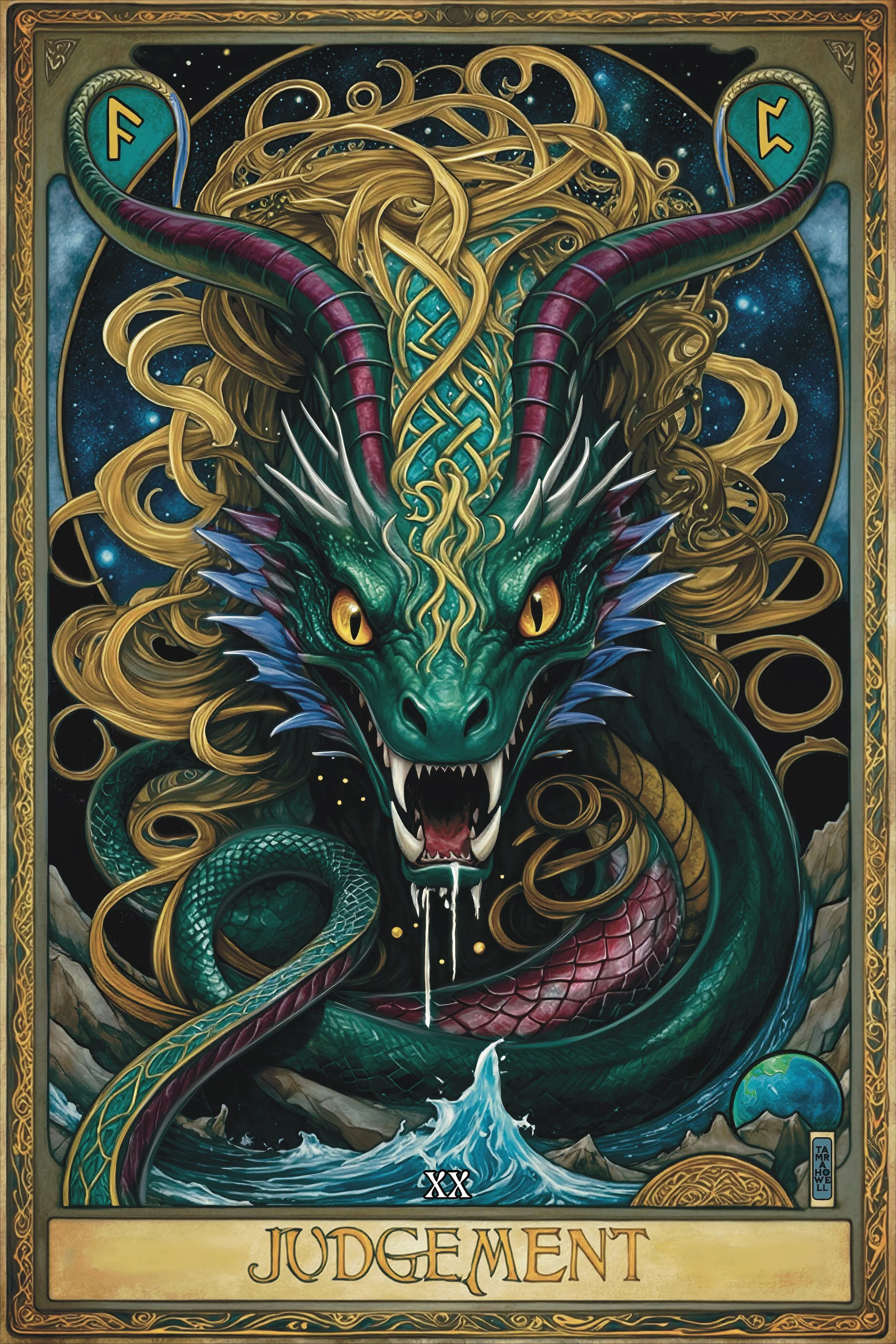Jörmungandr as JUDGEMENT
Unraveling the Mystery of Jormungandr: The Norse World Serpent
Judgement, THowell, 2025
In the Olensdottir Tarot, the Judgement card is embodied by Jormungandr, the immense Midgard Serpent from Norse mythology, coiling through a cosmic seascape with a fierce, snarling visage. This card, inspired by the Rider-Waite-Smith tradition, traditionally represents awakening, rebirth, and a call to reckoning, often depicted as an angel trumpeting to raise the dead from their graves for final judgement. Here, Jormungandr's release from encircling the world at Ragnarok serves as that transformative call, its massive form emerging from turbulent waves amid a starry void, symbolizing the end of one cycle and the dawn of renewal. The serpent's golden mane flows like solar rays, and its scales glisten with otherworldly power, evoking a moment of cosmic upheaval where past actions are confronted, leading to enlightenment and rebirth—a Norse twist on judgement as an apocalyptic revelation rather than divine verdict.
In Norse belief, Jormungandr, offspring of Loki and the giantess Angrboda, is cast into the ocean by Odin to encircle Midgard, biting its own tail in an ouroboros-like symbol of eternity and containment. At Ragnarok, it releases its tail, poisoning the sky and battling Thor in mutual destruction, which floods the world and paves the way for a new, fertile era. This mirrors the card's theme of liberation from old bonds, self-evaluation, and transcendent change, emphasizing judgement as a fated reckoning that destroys to recreate, aligning with Norse cycles of destruction and regeneration.
The illustration’s color palette amplifies its symbolic intensity. Deep greens and teals in Jormungandr's scales and the waves convey mystery, depth, and the primordial sea, representing hidden truths rising to the surface. Golds and yellows in the mane and eyes evoke divine illumination and awakening, symbolizing the fiery spark of realization amid chaos. Purples and blues in the starry background suggest cosmic vastness and intuition, while the fiery accents in the serpent's gaze highlight transformative passion—the raw power of judgement. This blend of cool, watery tones with warm, radiant highlights reflects the Norse duality of ocean depths and celestial fire, echoing the dramatic shift from submersion to emergence.
Adhering to the traditional Judgement card’s essence, Jormungandr's snarling emergence parallels the angelic trumpet call, awakening dormant potentials and urging accountability. The absence of human figures shifts focus to universal forces, while the small globe and celestial bodies in the background echo the resurrection motif, signifying a world reborn. Though more ominous and serpentine than the serene RWS depiction, this Norse interpretation invites readers to embrace judgement as a liberating force, making it a profound evolution of the archetype. In the Olensdottir Tarot, Judgement is not punitive but a cosmic summons, forged in Ragnarok's chaos, where releasing the tail unleashes renewal.
Color Symbolism
Deep Greens and Teals: Symbolize mystery, depth, and the primordial ocean, representing submerged truths and emotional undercurrents rising for judgement.
Golds and Yellows: Evoke illumination, awakening, and divine energy, highlighting the spark of realization and rebirth amid destruction.
Purples and Blues: Convey cosmic vastness, intuition, and spiritual insight, suggesting the infinite scope of self-evaluation and fate.
Fiery Oranges and Reds: Accent passion, transformation, and intensity, embodying the chaotic power of Ragnarok and the urgency of the call to awaken.
Thematic Symbolism
Awakening and Reckoning: Jormungandr's release from its tail-biting pose signifies breaking free from cycles, calling for self-assessment and enlightenment.
Destruction and Renewal: The serpent's role in Ragnarok represents the necessary end of old worlds to birth new ones, mirroring themes of rebirth.
Eternity and Cycles: The ouroboros motif (tail in mouth) symbolizes eternal return, with its release marking a pivotal judgement point.
Cosmic Chaos: The starry void and waves evoke universal upheaval, emphasizing judgement as a fated, transformative event beyond human control.
Divine Confrontation: The fierce gaze and mane suggest facing inner truths with courage, leading to transcendent growth.
Comparison to Rider-Waite-Smith (RWS) Judgement
Call to Awakening: Both feature a summons—RWS with an angel's trumpet raising the dead, and this with Jormungandr's emergence signaling Ragnarok's rebirth.
Rebirth and Renewal: RWS shows resurrection from graves; here, the serpent's release floods and renews the world, amplifying cosmic regeneration.
Reckoning: RWS emphasizes divine judgement; this shifts to fated self-reckoning, with Jormungandr as a neutral force of change rather than a benevolent angel.
Differences in Tone: RWS is hopeful and communal with human figures; this is more solitary and ominous, focusing on mythic scale and personal confrontation.
Symbolic Elements: The RWS cross and mountains align with the globe and waves here, both representing a new era dawning after evaluation.
Norse Ideals the Card References
Ragnarok: The apocalyptic renewal embodies the belief in cyclical destruction leading to a better world, highlighting impermanence and resilience.
Fate (Wyrd): Jormungandr's predestined role underscores acceptance of inevitable change and the interconnected web of destiny.
Balance of Forces: The serpent's containment of Midgard reflects harmony between chaos and order, disrupted for necessary transformation.
Heroic Confrontation: Echoing battles like Thor vs. Jormungandr, it promotes facing doom with valor, valuing the act over the outcome.
Cosmic Interconnection: As a world-encircler, it ties to Yggdrasil's unity, emphasizing judgement as part of the greater Norse cosmology.
